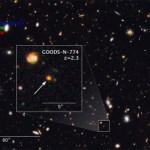Keck Observatory Spots ‘Monster Galaxy’ Formation
Yale University astronomers announced today the discovery of a window into the early, violent formation of the nuclei of the universe’s monster galaxies.
Using the 10-meter W.M. Keck Observatory Telescope atop Mauna Kea, the team from Yale was able to witness a turbulent, star-bursting galactic core forming millions of stars at a ferocious rate.
The find offers important clues about the galaxy’s development 11 billion years ago, early on in the life of the universe, approximately three billion years after the Big Bang.
After having earlier spotted a potential candidate with the 2.4-meter Hubble Space Telescope, the team spent five days in Hawai`i collecting data using the Keck Observatory equipment.
Although galaxy formation theories have long suggested the “inside out” formation of monster elliptical galaxies, this marks the first time scientist have been able to actually observe this galactic construction process at its core.
Erica Nelson, Yale graduate student and lead author of a paper being published on the find in the Journal of Nature, described the early universe as being a “Hotter, more turbulent place,” and explained, “The early universe could make these galaxies, but the modern universe can’t.”
Nelson and her team got to witness the formation process starting on Jan. 11, 2014 using Keck’s “Near Infrared Spectrograph” (NIRSPEC) instrument.
The monster galaxy formation, named “Goods-N-774,” quickly became referred to simply as “Sparky.”
The scientists found that Sparky is producing 300 stars per year, roughly 30 times the number of stars being produced by our own Milky Way. Although Sparky is only 6% the size of the Milky Way, it already contains roughly twice the number of stars.
The tip-off to locating Sparky was an already-predicted presence of rapidly orbiting gas clouds.
In fact, observations from Keck Observatory showed the galaxy boasts the most rapidly orbiting gas clouds ever measured, offering scientists firm proof that they were in fact witnessing the core of a monster galaxy in formation.
“Keck Observatory’s NIRSPEC provided crucial information,” said Nelson,“ adding that without the data from the Keck Observatory, scientists would have found what was happening “hard to interpret.”
As it turns out, Sparky may not be alone.
“We suspect there are 100 times as many and we’re just missing them,” explained Nelson.











